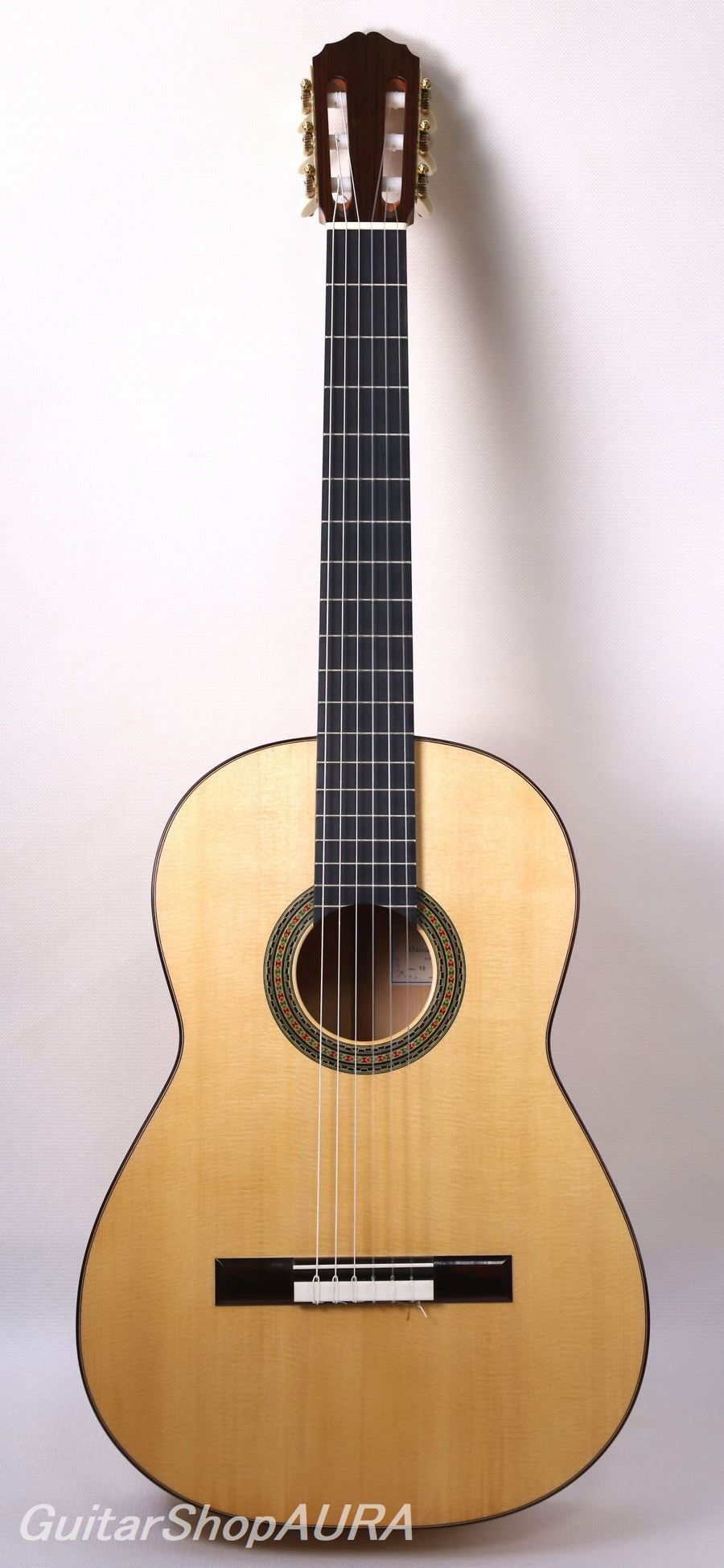
| Instrument | Daisuke Kuriyama |
| Category | Japanese Classical Guitars 〔Used〕 |
| Number/Model | model Santos Hernandez No.98 |
| Scale length | 650mm |
| Country | Japan |
| Year | 2023Year |
| Top | Solid Spruce |
| Side&Back | Solid Cypress |
| Condition※ | 7 |
| List price | INQUIRE |
| Price (tax included) | Please Inquire |
| option |
Click to enlarge the photos below
Neck: Cedro
Fingerboard: Ebony
Finish(Top): Shellac
Finish(Back & Sides): Shellac
Tuning Machines: PINWELL
String Height(1st): 2.9mm
String Height(6th): 3.9mm
[Profile]
Daisuke Kuriyama (Born in 1981)
Daisuke Kuriyama began making guitars on his own while attending Tokyo Zokei University. After graduating, he joined a major musical instrument store in 2003, working in the repair department for over 10 years. During this time, he had the opportunity to study many renowned instruments, both domestic and international, in person. This experience played a key role in developing his exceptional sense of balance and sensitivity to tone, which supports his unique sound.
While working at the store, he was introduced to the luthier Kaoru Ono, and since 2010, he has been receiving direct guidance at Ono’s workshop. Subsequently, he became independent, producing high-quality guitars with extremely intricate craftsmanship at a pace of about 6 to 8 instruments per year. His instruments, which are based on traditional Spanish techniques such as those of Torres, Domingo Esteso, and Marcelo Barbero I, embody the rich, warm tone of classic Spanish guitars. These instruments have become beloved by users from various genres.
In 2020, his interview and instruments were featured in Orfeo Magazine No. 15, published by the French publisher Camino Verde.
[Description]
This is the arrival of a 2023 model, Daisuke Kuriyama's Santos Hernández model, No. 98. For those who are exploring the essence of the Spanish guitar (whether luthiers or guitarists), Santos Hernández (1874–1943) is an essential milestone, and one must first pass through his works to find the best answers and potential for new challenges. For Kuriyama, who has previously created homage models to Torres, Manuel Ramírez, Hauser, and Bouchet, Santos Hernández is a pivotal figure in the history of guitar making, and as such, his Santos model has naturally become a core piece in Kuriyama’s lineup.
This particular instrument follows the 1924 Santos Hernández housed at the Guitar Museum, a guitar Kuriyama himself has personally examined and considers one of the finest examples. (A precise blueprint of this Santos, based on measurements by luthier Jun Nakano, is available for sale at the Guitar Museum.) Kuriyama's homage models in recent years have shown remarkable results, and this guitar is no exception, being an exceptionally complete Santos model.
A consistent feature of Kuriyama’s homage models is the pure sonic reproduction derived from original designs, and the resolution at every level is particularly noteworthy. Many similar replica models of the Santos aim to recreate the mature sound of a century-old guitar. In contrast, Kuriyama takes a more principled approach, directly extracting the sound of the Santos as it was originally intended—its pristine tone as a new guitar.
The top bracing structure includes a harmonic bar above and below the sound hole (neck side and bridge side), a thin reinforcing plate with a gable shape between the upper bar and the neck foot, additional bracing around the sound hole, and seven symmetrically placed fan braces. The ends of these braces are supported by two closing bars arranged in an inverted V shape at the bottom. The weight of the guitar is 1.33 kg.
The resonance is set with a solid, low center of gravity just above F, designed to produce a distinctly Spanish tone, from a thick bass to sharp highs. The sound is dense and viscous, almost as if the elasticity of the wood itself is transformed into the tone, offering a sound that is both bright and crisp due to the use of sheep's wool material. The guitar vibrates vividly, with no extraneous noise, and the sound feels incredibly realistic, as if it is present in the room with you. The response to playing and expression is sharp and sensitive, and the musical potential of the guitar is outstanding.
The treble side of the top shows some playing marks, though none are particularly deep. There are also some minor paint touch-ups on the 1st string side beneath the bridge. The back and sides show some slight scuffs or cloudiness in the finish, but nothing too noticeable. The neck and frets are in excellent condition. The neck has a slightly thicker D-shape, with string action set at 2.9 mm on the 1st string and 3.8 mm on the 6th string (at the 12th fret), and the saddle has 2.5 mm of extra height, allowing for further adjustment if needed. The tuners have been replaced with Pinwell-made tuners and are functioning well.